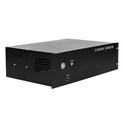Hey there! I'm a supplier of ultrasonic rings, and I'm super stoked to chat with you about how these nifty gadgets work. Ultrasonic rings, like our ResoRing-30 Ultrasonic Ring and ResoRing-25 Ultrasonic Ring, are pretty amazing pieces of tech that have a wide range of applications.
Let's start with the basics. An ultrasonic sensor in an ultrasonic ring is all about using sound waves that are way beyond the range of human hearing. These sound waves, which have frequencies higher than 20,000 Hz, are the key to how the sensor operates.
The core of the ultrasonic sensor in an ultrasonic ring is the transducer. This little guy is like the heart of the operation. It's responsible for both sending out the ultrasonic waves and receiving the echoes that bounce back. The transducer is made up of special materials, usually piezoelectric crystals. When an electric current is applied to these crystals, they vibrate at a really high frequency, creating those ultrasonic waves.
So, how does the whole process work? Well, it's kind of like how a bat uses echolocation to find its way around in the dark. The ultrasonic ring's sensor sends out a short burst of ultrasonic waves. These waves travel through the air or whatever medium they're in (it could be a liquid in some cases) at a known speed. When these waves hit an object in their path, they bounce back as echoes.
The sensor then waits for these echoes to return. By measuring the time it takes for the echoes to come back, the sensor can figure out how far away the object is. It's a simple matter of using the formula distance = speed x time. Since we know the speed of sound in the medium (it's about 343 meters per second in air at room temperature), and we measure the time it takes for the wave to go to the object and back, we can calculate the distance.
Let's break it down a bit more. When the transducer sends out the ultrasonic wave, it's like throwing a ball against a wall. The ball (the wave) goes out, hits the wall (the object), and then comes back to you. The sensor keeps track of the time from when it sent the wave until it receives the echo. This time is called the time-of-flight.
Now, there are a few things that can affect the accuracy of the measurement. For example, the temperature and humidity of the air can change the speed of sound. If it's really hot or really humid, the speed of sound will be different than in normal conditions. But most modern ultrasonic sensors are smart enough to compensate for these changes. They might have built-in temperature sensors to adjust the calculations accordingly.
Another factor is the surface of the object. If the object has a smooth surface, the ultrasonic waves will bounce back more easily, and the echo will be stronger. But if the surface is rough or porous, some of the waves might get absorbed or scattered, making the echo weaker. This can sometimes lead to less accurate measurements.


Ultrasonic rings have a bunch of cool applications. One of the most common uses is in distance measurement. They can be used in industrial settings to measure the level of liquids in tanks. For example, if you have a big storage tank filled with oil or water, an ultrasonic ring can be installed at the top of the tank. It sends out ultrasonic waves, and by measuring the time it takes for the echoes to come back, it can tell you how much liquid is in the tank.
They're also used in robotics. Robots can use ultrasonic rings to navigate around their environment. The sensors can detect obstacles in the robot's path, allowing it to avoid collisions. It's like giving the robot a pair of super ears to "see" what's around it.
In the automotive industry, ultrasonic rings are used in parking assist systems. When you're trying to park your car, these sensors can detect how close you are to other cars or objects around you. They send out signals and measure the echoes to give you a clear idea of the distance, so you don't accidentally bump into something.
Now, let's talk a bit about our ResoRing-30 Ultrasonic Ring and ResoRing-25 Ultrasonic Ring. These rings are designed with high-quality transducers and advanced signal processing algorithms. They offer really accurate distance measurements, even in challenging environments.
The ResoRing-30 has a longer range, making it great for applications where you need to measure longer distances. It's also more sensitive, so it can detect smaller objects. On the other hand, the ResoRing-25 is more compact and has a shorter range, but it's perfect for applications where space is limited.
If you're in the market for an ultrasonic ring, whether it's for an industrial project, a robotics application, or something else, we've got you covered. Our rings are reliable, easy to install, and offer great performance.
We understand that every project is different, and you might have specific requirements. That's why we're here to work with you. Whether you need help choosing the right ring for your application or you have questions about how to integrate it into your system, our team of experts is ready to assist you.
If you're interested in learning more or want to start a purchase negotiation, don't hesitate to reach out. We're eager to discuss your needs and find the best solution for you.
References:
- "Ultrasonic Sensors: Theory and Applications" - A comprehensive guide on the principles and uses of ultrasonic sensors.
- "Piezoelectric Materials for Ultrasonic Transducers" - A study on the materials used in ultrasonic sensors and their properties.





